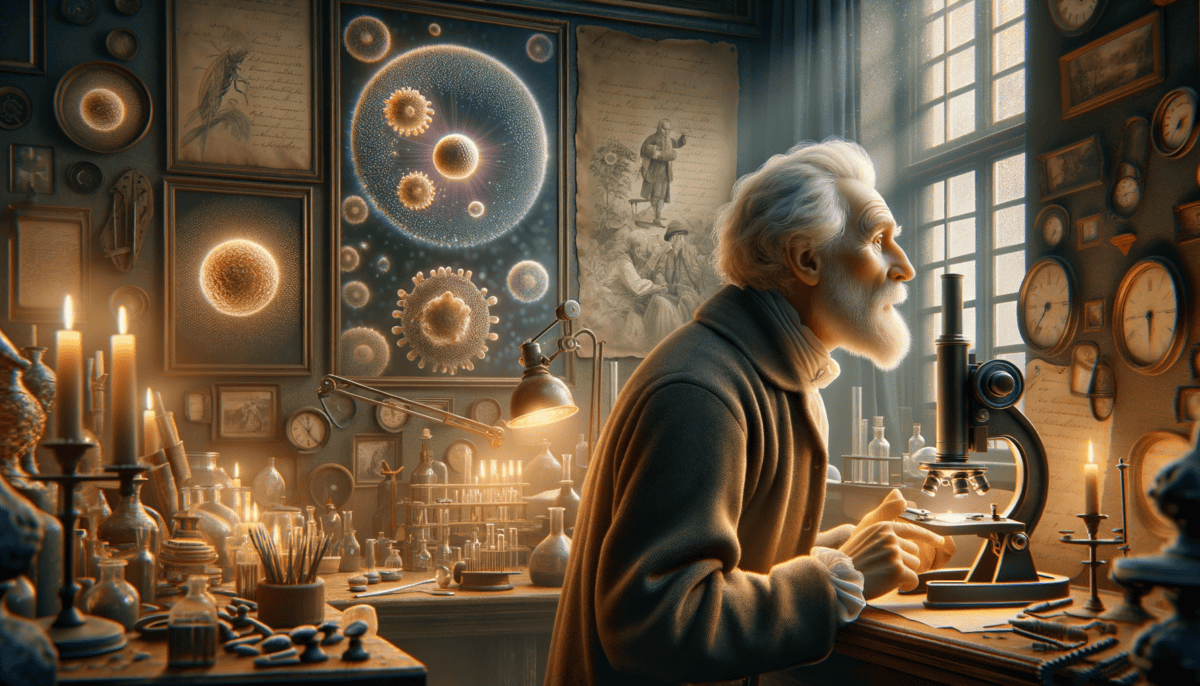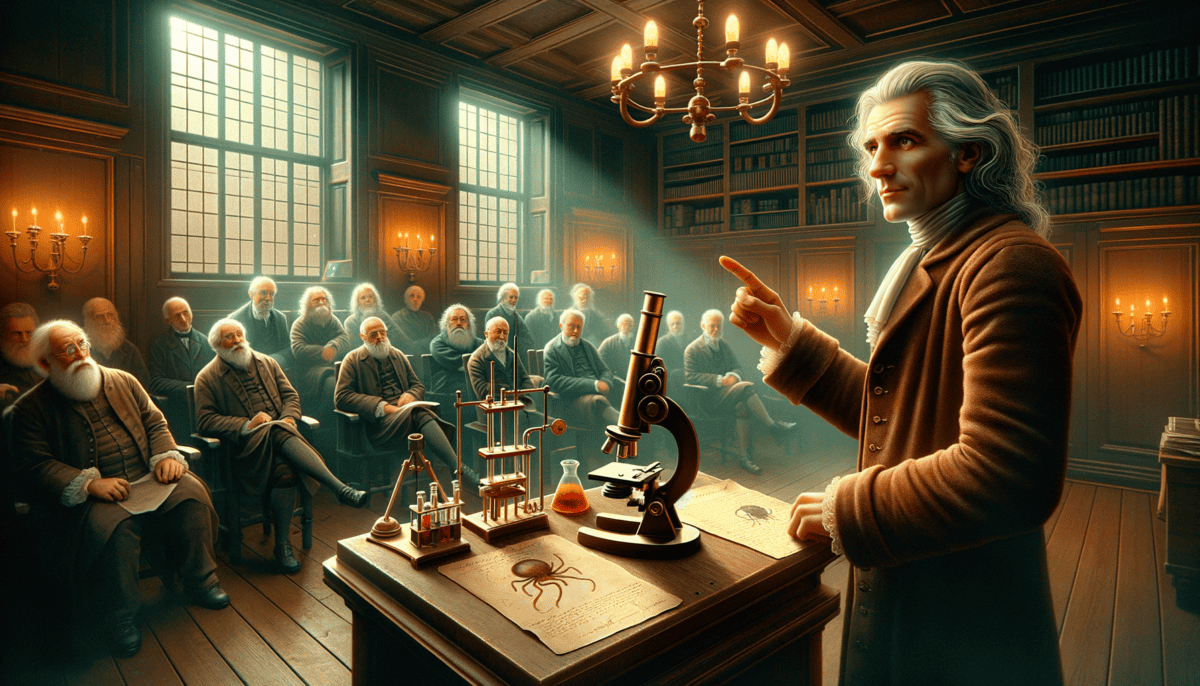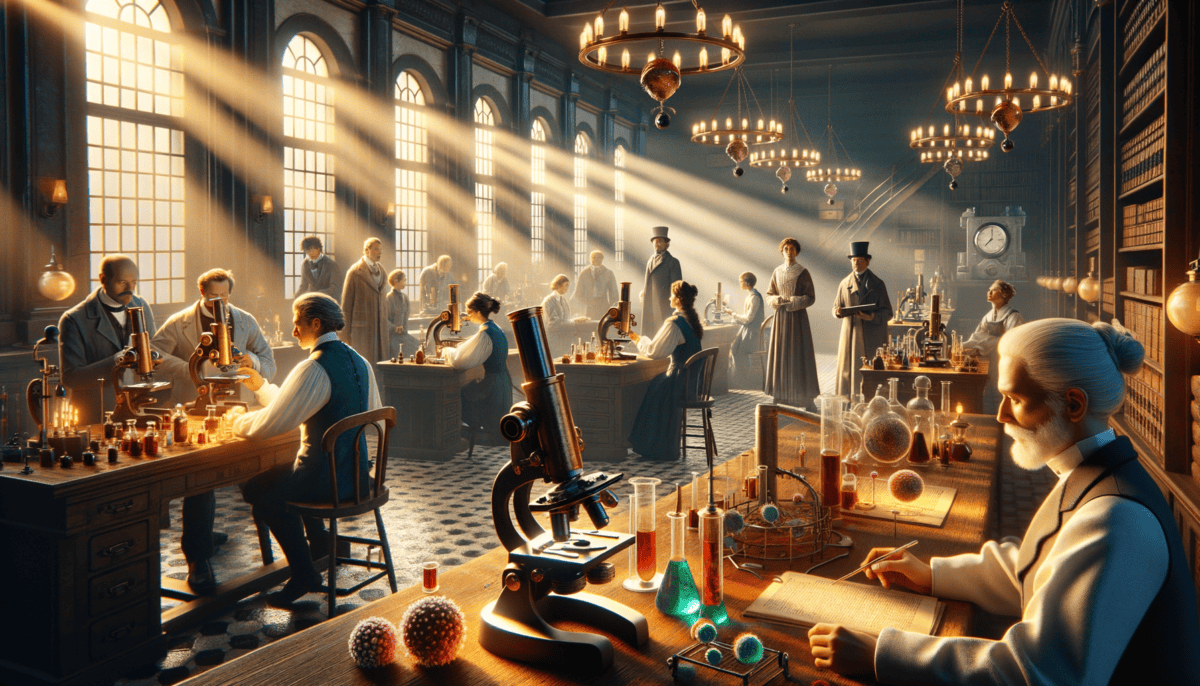The Curious Lens
Have you ever looked at something really tiny and wished you could see it better? That’s exactly what Hans and Zacharias Janssen thought about in their little workshop in the Netherlands, way back in the 1590s.
“Father, what if we could make things look bigger than just regular glasses do?” young Zacharias asked one day, holding up a curved piece of glass.
“That’s an interesting thought,” Hans replied, his eyes twinkling with excitement. “Let’s try something new!”
Together, they played with different glass pieces. They noticed something amazing – when they put two special curved glasses together in a tube, things looked much, much bigger!
A Special Discovery
The father and son team worked in their cozy workshop, surrounded by pieces of glass and tools. They tried different ways to make things look bigger:
- They put one glass lens at the top of a tube
- They put another lens at the bottom
- They moved the lenses closer and further apart
- They looked at tiny objects through their tube
What they made was very special – it was the world’s first compound microscope!
“Look, father!” Zacharias exclaimed. “The tiny grains of sand look like huge rocks now!”
Hans smiled proudly. “This is just the beginning, son. Think of all the tiny things we’ll be able to see!”
Spreading the News
Other people heard about their amazing invention. Scientists and curious people came from all around to see this magical tube that could make tiny things look big.
Some visitors gasped in wonder when they looked through the microscope. “It’s like magic!” they would say. But it wasn’t magic – it was science!
Their simple tool would grow into something much more important. It would help doctors learn about diseases, scientists discover tiny living things, and change how we see our world.
Hans and Zacharias may not have known it then, but their curious minds and clever hands had opened a door to a whole new way of looking at things. Their invention would help people see things that no one had ever seen before!
A Glimpse of the Unknown
In a small shop in Delft, Holland, there lived a curious man named Antonie van Leeuwenhoek. He wasn’t a fancy scientist – he sold cloth and buttons! But he had a special hobby that would change the world.
“I wonder what I might see today?” Antonie would say to himself as he carefully shaped each glass bead. He was very good at making these special lenses.
The Magic of Tiny Lenses
Unlike the Janssens’ long tube microscope, Antonie made something different. His microscope was simple – just one tiny glass bead held in a small metal plate. But it could make things look hundreds of times bigger!
“Look at this drop of water!” he exclaimed one day. “It’s full of tiny swimming creatures!” What Antonie saw that day was amazing – he was the first person ever to see bacteria!
- In pond water
- Between his teeth
- In pepper water
- Even in rain drops!
A World of Wonders
Every day, Antonie would look at something new. He drew pictures of everything he saw. His drawings were careful and detailed, showing these tiny creatures to others for the first time.
“These little animals,” he wrote in his notes, “are smaller than any creatures we have ever known about!” He called them “animalcules” – which means “tiny animals.”
People started calling him “the Father of Microbiology” because he was the first to see and study these tiny living things. But Antonie didn’t care about fancy titles – he just loved exploring this invisible world.
“There are more wonderful things in the smallest bit of matter than anyone has ever dreamed of,” he would tell visitors who came to see his discoveries.
Sharing His Discoveries
Antonie wrote letters about everything he saw to the Royal Society in London. He wanted to share his amazing findings with other scientists. But would they believe what he saw through his tiny lenses?
His careful work and clear drawings helped others understand this new tiny world. Soon, more people wanted to look through microscopes and see these wonderful things for themselves!
As the sun set each evening in Delft, Antonie would smile, knowing that tomorrow might bring another amazing discovery in his magical world of tiny things.
Proving the Impossible
Not everyone believed Antonie’s amazing discoveries. “How can there be tiny animals swimming in a drop of water?” they asked. Many people thought he was making up stories!
The Big Challenge
The Royal Society in London was a group of important scientists. They wanted proof of Antonie’s tiny creatures. “Show us these animals,” they said in a letter. “Let us see them with our own eyes!”
This was hard because Antonie’s microscopes were tricky to use. Only he knew exactly how to make them work just right. But he didn’t give up!
A Clever Plan
Antonie had an idea. He invited important people to his shop to see for themselves. “Look here,” he would say, carefully helping them use his microscope. “Do you see the tiny creatures moving?” ️
• Kings and queens
• Scientists
• Even the famous artist Vermeer!
“It’s amazing!” they would gasp. “The tiny animals are real!” One by one, people started to believe.
Writing to the World
Antonie wrote many letters about what he saw. He drew careful pictures and explained everything clearly. “I want everyone to understand this new tiny world,” he said. ✍️
Scientists started making their own microscopes. They wanted to see these amazing tiny creatures too. Soon, more and more people were exploring the microscopic world.
A Victory for Science
“Never stop looking closely at things,” Antonie told young scientists who came to learn from him. “There are always new things to discover!”
Even when he was very old, Antonie kept studying his tiny creatures. He had shown the world something amazing – that there was a whole universe of life too small to see with just our eyes.
“Remember,” he would say with a smile, “sometimes the biggest discoveries come from looking at the smallest things.”
Thanks to Antonie’s hard work and bravery, people now knew about bacteria and other tiny living things. His discoveries would help scientists understand many important things about health and disease in the years to come.
The Microscope Saves Lives
A young doctor named Robert Koch sat at his desk late one night. Through his microscope, he watched tiny dots move around. “These small germs must be making people sick!” he said excitedly.
A Mystery to Solve
People were getting very sick in towns and cities. Doctors didn’t know why. But thanks to microscopes, they could now see tiny germs everywhere!
Blood Cells and More
Scientists looked at drops of blood under microscopes. They saw amazing things floating around:
• Red cells that carry oxygen
• White cells that fight germs
• Tiny plates that help heal cuts
“Now we can understand how our bodies work!” the scientists said happily. “This will help us make people better!” ❤️
Fighting Disease
Louis Pasteur was another smart scientist. He used his microscope to study germs that made milk go bad. “If we heat the milk just right,” he said, “we can kill the bad germs!”
Helping People Get Better
Doctors started using microscopes to find out why people were sick. They could see the germs causing problems and give the right medicine to help.
“This is like having magic eyes!” one doctor said. “We can finally see what makes people sick and help them feel better!”
Making Medicine Better
Scientists worked hard in their laboratories. They used microscopes to make new medicines. These medicines could fight the bad germs and help sick people get well.
“The microscope is like a superhero tool,” a young scientist said. “It helps us see the bad guys – the germs – so we can stop them!”
Thanks to microscopes, doctors learned how to keep people healthy. They could see things no one had ever seen before. This changed medicine forever and helped save many lives!
Amazing New Microscopes
Scientists kept making microscopes better and better! Each new microscope could see smaller things than before. It was like getting super-powered eyes!
Better and Brighter
A clever scientist named Ernst Abbe had a great idea. “If we use special glass and more lenses,” he said, “we can see things much clearer!” His new lenses made everything look brighter and sharper. ✨
Light Makes Magic
Scientists learned to use different kinds of light in microscopes. Some used special blue light. Others used bright white light. Each type helped them see different things!
“It’s like having different superhero powers,” said one excited scientist. “Each type of light shows us something new!”
The Super-Strong Microscope
In 1931, something amazing happened. Scientists made a new kind of microscope that didn’t use light at all! It used tiny electric particles called electrons. ⚡
Digital Dreams
Modern microscopes use computers to help see things even better. They can take pictures and make them look 3D! ️
• They can take pictures
• They connect to computers
• They can make 3D images
• They use special colored lights
• They can record videos
Tiny Robots Help Too
Some new microscopes have tiny robot helpers! These robots can move samples around and take pictures all by themselves. “It’s like having a tiny laboratory assistant,” laughed one scientist.
Going Even Smaller
Today’s strongest microscopes can see things smaller than ever before. They can even see single atoms – the tiny building blocks that make up everything!
Scientists keep making new kinds of microscopes. Each one helps us learn more about our amazing world. Who knows what exciting things we’ll discover next?
A World of Wonder
Today’s microscopes are helping us discover amazing new things! Scientists use them to explore everything from tiny germs to the smallest parts of our bodies.
Helping People Get Better
Modern microscopes are like super-powered doctor’s helpers! They can look inside cells to find out why people get sick. “These tools help us make better medicine,” says Dr. Sarah Lee with a smile. ⚕️
Exploring Space Rocks
Did you know scientists use microscopes to study rocks from space? They can see tiny crystals that formed billions of years ago!
“Each crystal tells us a story about our solar system,” explains space scientist Dr. James Chen. “It’s like reading a really old history book!”
Helping Our Planet
Scientists are using microscopes to help save our Earth too! They study tiny plants and animals in the ocean. This helps them protect our seas.
• Finding cures for diseases
• Making stronger materials
• Studying space rocks
• Protecting nature
• Creating better food
The Future is Bright
New microscopes keep getting better and better! Some can even make 3D movies of tiny living things. “It’s like having magical glasses that let us see a hidden world,” says young scientist Emma Wong.
• Watch how medicines work in real-time
• See inside atoms
• Take pictures of memories in our brains
A Journey of Discovery
From Hans and Zacharias Janssen’s first simple microscope to today’s amazing machines, we’ve come so far! Each new discovery helps us understand our world better.
The microscope started as a curious invention by two people who loved to learn. Now it helps millions of scientists make our world better every day!
What amazing things will we discover next? The adventure of exploring the tiny world continues, and you could be the next person to make an exciting discovery! ✨






